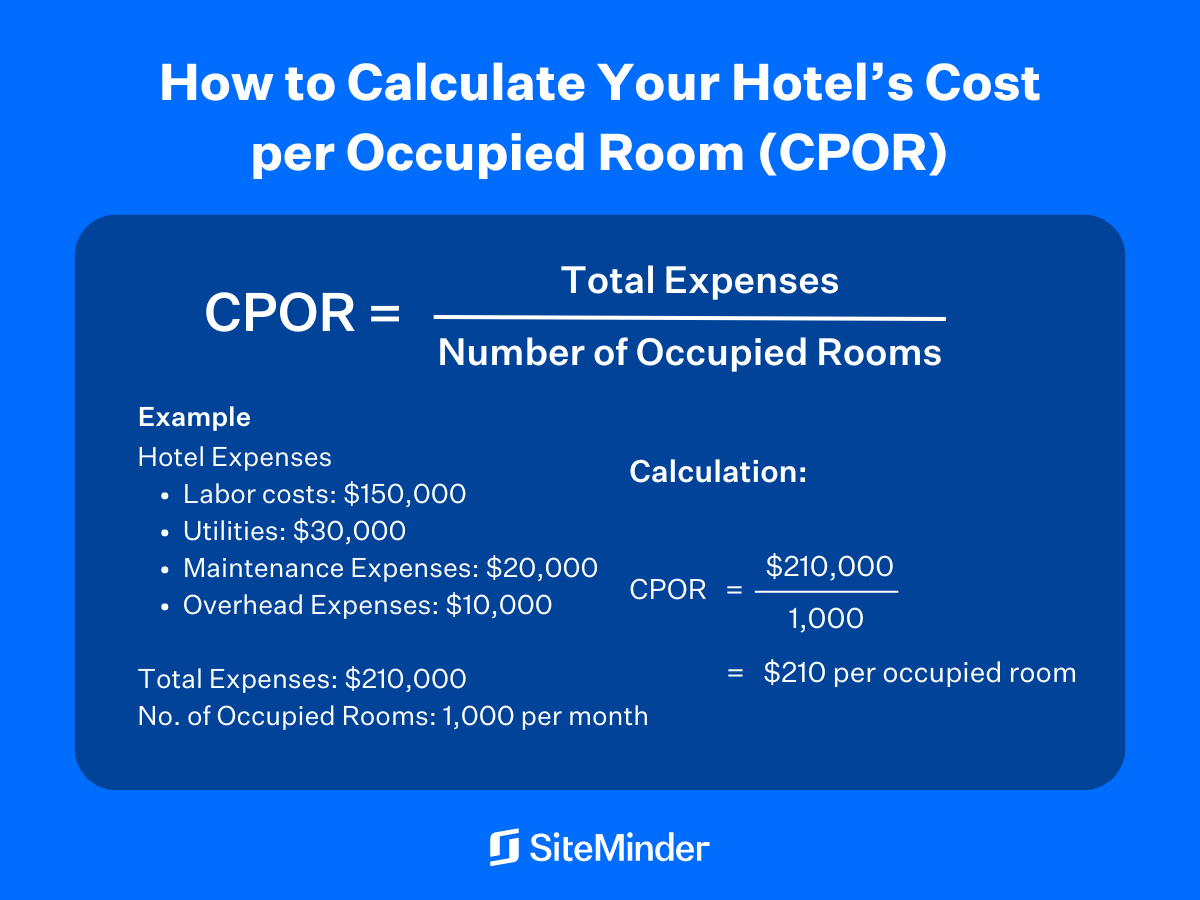What is CPOR?
CPOR is a crucial metric in the hotel industry that helps measure the efficiency and profitability of a hotel’s operations. It stands for cost per occupied room, which means the expenses that are being incurred by rooms that have guests staying in them.
CPOR can be influenced by a number of factors and can often be a representation of how effective your revenue management and marketing strategies are.
What are variable costs per occupied room?
Variable costs per occupied room are costs that can fluctuate, due the number of guests in the room for example. These may include supplies, utilities, or laundry services.
This is different from fixed costs, which remain stable regardless of guest numbers, such as staff salaries, property taxes, insurance and more.
What is cost per occupied room in housekeeping?
In housekeeping, cost per occupied room has a similar meaning as it does for a hotel generally. It is used to measure the efficiency and cost-effectiveness of housekeeping operations. It calculates the average cost associated with cleaning and maintaining each occupied room.
Labour costs, supply costs, and equipment costs can all play a role in how healthy the CPOR is.
This blog will give you a full overview of CPOR at your hotel and how you can manage it effectively. Table of contents
Why is cost per occupied room an important metric?
Cost per occupied room is an important metric because it can help you understand how efficient your hotel is and give you ways to improve your revenue management and optimise your profitability.
Using CPOR as a key metric enables:
- Clearer performance evaluation: CPOR provides a clear picture of your hotel’s operational health. A lower CPOR indicates that your business has a good handle on costs and resources.
- Profitability analysis: CPOR can be directly linked to your hotel’s profitability. A lower CPOR means that you are generating more revenue per occupied room, which can lead to higher profit margins.
- Effective cost management: By analysing CPOR, hotels can identify areas where costs can be reduced. This can involve optimising labour schedules, negotiating better deals with suppliers, or implementing energy-saving measures.
- Accurate benchmarking: CPOR can be compared to industry standards and competitors to assess a hotel’s performance. This allows hotels to identify areas where they need to improve and learn from best practices.
- Better decision making: CPOR can be used to inform important business decisions, such as pricing strategies, investment in new amenities, and staffing levels.
Lower your operating costs effortlessly with smart hotel technology Use SiteMinder’s platform to easily boost occupancy, maximise revenue, and create efficiencies for your business.
How to calculate cost per occupied room
To calculate your cost per occupied room you’ll need to divide the total operating costs of your hotel by the number of occupied rooms during a specific period.
The result will be influenced by a number of factors, including your:
- Occupancy rate: Higher occupancy rates generally lead to lower CPOR.
- Operating costs: Efficient management of operating costs can reduce CPOR.
- Pricing strategy: Higher room rates can increase revenue and potentially lower CPOR.
- Business mix: The type of guests (e.g., leisure, corporate) can also impact CPOR.
Cost per occupied room formula
The formula for cost per occupied room is as follows:
CPOR = Total Operating Costs / Number of Occupied Rooms for your chosen time period.
For example, if your hotel has 100 rooms and was operating at 70% occupancy during the month of January, you would have 2170 rooms occupied. If your total operating costs were $200,000, your CPOR would equal:
$200,000 / 2170 = $92.17
This will allow you to evaluate how happy you are with your operating costs and make plans to optimise it.

How to optimise your hotel CPOR
To optimise and improve your hotel’s CPOR, you can look at ways at which you can reduce costs, increase occupancy, or increase revenue – preferably all of the above.
Here are some of the best ways to create a healthier hotel CPOR.
Optimise efficiency
There’s a broad range of areas where you can improve efficiency across your hotel that will impact costs, such as:
- Staffing: Ensuring the staff schedule is optimised so you don’t have too many or too few staff working at any given time.
- Processes and procedures: Make sure everyone is aware of the correct way to do daily tasks such as housekeeping, invoicing, checking guests in and out etc.
- Energy use: Power saving methods such as efficiency lighting, eco-friendly water systems, or timers on air conditioners can dramatically reduce your monthly expenses.
- Waste management: Food and beverage, linen, and cleaning are all areas where you can become more efficient, depending on guest preferences and staff effectiveness. For example, giving guests the option NOT to have their linen replaced daily or their room to be cleaned daily.
Cost reduction
Efficiency and cost reduction often go hand in hand but there are specific ways to reduce costs that don’t involve day-to-day operations. These include:
- Resource management: Negotiating better deals with suppliers or finding new suppliers can help you reduce your expenditure.
- Expense tracking: Ensure you have processes in place that allow you to accurately track costs so you know where to take action.
- Automate daily tasks: Save time and money by using automated technology systems to replace inefficient manual work.
- Inventory management: Take steps to ensure you aren’t overordering or wasting stock and supplies.
Revenue management
Revenue management is a huge umbrella concept that deserves its own full guide but there’s a few key areas where you can boost revenue and profit:
- Optimise pricing: Make sure you are selling your rooms at the maximum value possible at all times.
- Boost revenue per guest: Offer enticing upsell and package offers to convince each individual guest to spend a little more.
- Increase ancillary revenue: Utilise your amenities and on-site services to drive additional revenue across every booking.
- Implement loyalty programs: Loyalty programs will help you maintain a high occupancy level and reduce your cost of acquisition.
- Create partnerships: Hire the spaces of your hotel out for other businesses to hold classes, training courses, or meetings.
Guest satisfaction
Guest satisfaction can go a long way to boosting revenue and also lowering your marketing costs.
By improving guest experiences you’ll be able to:
- Drive repeat bookings
- Generate positive reviews
- Increase spend per guest
- Benefit from word-of-mouth marketing
Creating a better reputation will ultimately allow you to charge higher rates for your hotel because guests will have more trust that they will be getting a great experience.
Tools to help you improve CPOR
The hotel industry has plenty of technology solutions that enable you to optimise your cost per occupied room.
Some of the best examples include:
- Property management systems: Your PMS will help you centralise your daily operations and manage tasks and guests more effectively. With automation and real-time processing, you’ll achieve more in less time and with less errors.
- Channel managers: A channel manager will optimise your distribution, allowing you to sell your entire inventory across multiple channels at the same time, with automatic real-time updates ensuring you don’t encounter double bookings and can reach more guests.
- Booking engines: Using a booking engine will allow you to take direct bookings from your own website, via social media, and via metasearch so you don’t have to pay third-party commission fees.
- Guest engagement tools: Guest engagement tools can help streamline the check-in process, build a stronger relationship, and communicate more effectively.
- Business intelligence: Business intelligence enables you to track local market conditions, be aware of your own rate parity, and analyse key performance reports to optimise revenue.
- Pricing optimisation: There are many tools that can enable pricing optimisation, including dynamic tools that give you live recommendations and alert you to demand-driving events and opportunities.
Generally, many of these solutions can be accessed by one provider, such as a smart platform like SiteMinder.

